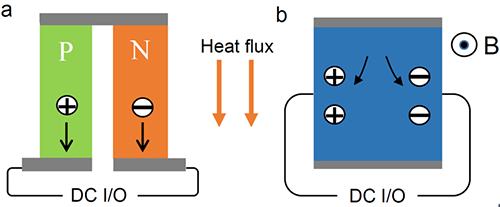[ Instrument Network Instrument R & D ] Thermoelectric materials can realize direct conversion between temperature difference and electrical energy. For remote space probes, radioisotope-powered thermoelectric generators power the system. It has been successfully applied to spacecraft such as Voyager One and Galileo Mars Rover launched by NASA. Both the use of natural temperature difference and industrial waste heat can be used for thermoelectric power generation. It can use non-polluting energy existing in nature and has good comprehensive social benefits. As a new energy and refrigeration material, thermoelectric materials have a series of advantages such as no vibration, no noise, no maintenance, and can be integrated. They have a wide range of applications in space technology, microelectronics and information technology.

However, the conversion efficiency of current thermoelectric materials is still low, which limits their application. Traditional thermoelectric materials are mainly doped narrow-bandgap semiconductors, and their efficiency is limited by several basic physical reasons. Two aspects are particularly important: On the one hand, the thermoelectric effects of electrons and holes have opposite signs, and the two compensate each other to reduce the total thermoelectric effect of the material. On the other hand, Wiedemann-Franz's law determines the approximate ratio of electrical conductance and thermal conductance, which cannot be optimized independently.
The thermoelectric transport coefficient is a tensor, and the current thermoelectric material design only considers the longitudinal effect, that is, thermoelectric transport with parallel temperature difference and voltage. The vertical transverse thermoelectric effect of the two is generally very small, and usually requires an external magnetic field, which is rarely paid much attention to.
The so-called thermoelectric effect is a phenomenon in which an electric current or a charge is accumulated when an electron (hole) in a heated object moves from a high temperature region to a low temperature region with a temperature gradient. The magnitude of this effect is measured using a parameter called thermopower (Q), which is defined as Q = E / -dT (E is the electric field due to charge accumulation, and dT is the temperature gradient).
The latest collaborative research by Xiang Junsen, Ph.D. from the Institute of Physics, Chinese Academy of Sciences / Beijing National Center for Condensed Matter Physics, researcher Sun Peijie, and superconducting laboratory researcher Chen Genfu shows that Dirac semi-metal cadmium arsenide Cd3As2 is in a small magnetic field There is a large lateral thermoelectric (Nernst) effect, and a lateral thermoelectric figure of merit zT as high as 0.5 (2T) can be obtained at room temperature. This result means that in topological electronic materials, the lateral thermoelectric effect where the temperature difference and voltage are perpendicular to each other is much larger than previously thought, and the application of thermoelectric materials is not necessarily limited to the longitudinal direction where the temperature difference and voltage are parallel. If the lateral thermoelectric effect is used, the above difficulties of the traditional thermoelectric effect can be skillfully "bypassed" and transformed into the unique advantages of the lateral thermoelectric effect.
Lateral thermoelectric effects no longer distinguish between electrons and holes. The effects of the two are equivalent and superimposed on each other. Charge-hole compensation results in enhanced lateral thermoelectric effects. In practical applications, the tandem structure of n-type and p-type materials is no longer needed. In addition, because the directions of heat flow and current are perpendicular, the restrictions of Wiedemann-Franz's law are lifted, and the conductance and thermal conductance can be optimized relatively independently. More importantly, the Bailey curvature caused by the band structure of topological materials can produce additional anomalous lateral thermoelectric effects, whose size can be adjusted by changing the Fermi energy.
Topological metal has a special band structure, which contains some singularities of the band structure. Simply put, it is the intersection of two energy bands, which can be described by the chiral relativity Weyl equation. Different from two-dimensional space (for example: graphene), in three-dimensional momentum space, such an energy band intersection is a very stable topology. The mass term cannot be introduced, that is, the energy gap cannot be opened by perturbation. Very stable.
For topological semimetals, the external magnetic field required to generate large lateral thermoelectric effects can in principle be small, and the magnetic field of ordinary rare earth permanent magnets may already be sufficiently large. If we further consider the magnetic topological system, the huge lateral thermoelectric effect can even appear under zero magnetic field, without relying on any external magnetic field. This will greatly enrich the potential application scenarios of this effect.

Topological semimetals are a new class of topological electronic states different from topological insulators. The band-crossing degeneracy point Weyl node is located exactly on the Fermi surface, which will give a very special kind of topological semimetal of electronic structure. Crystal materials can be divided into two categories: metals and insulators according to their electronic structures. Research on topological insulators in recent years shows that insulators can be further subdivided into general insulators and topological insulators. Topological insulators can exhibit completely different quantum phenomena and physical properties than ordinary insulators, such as: topologically protected surface states, anti-weak localization, quantum spin / anomalous Hall effect, and so on.
Just as the lateral Hall conductance of many topological semimetals can be much larger than the conventional longitudinal conductivity, the lateral thermoelectric effect can also be much larger than the conventional longitudinal thermoelectric effect. This is worth the attention of related experimental and theoretical researchers, and it is of great significance for exploring new thermoelectric materials and finding related applications of topological materials.
Source: Institute of Physics, Baidu Encyclopedia
The company's environmental engineering equipment mainly includes environmental fog gun machine, environmental cutting machine, engineering washing machine, engineering electric trolley and so on. It is the ideal equipment for low emission and low pollution in engineering.
Environmental protection equipment is used to control environmental pollution. Environmentally friendly activated carbon improves environmental quality and has mechanical products, structures and systems manufactured and built by production units or building installation units.

